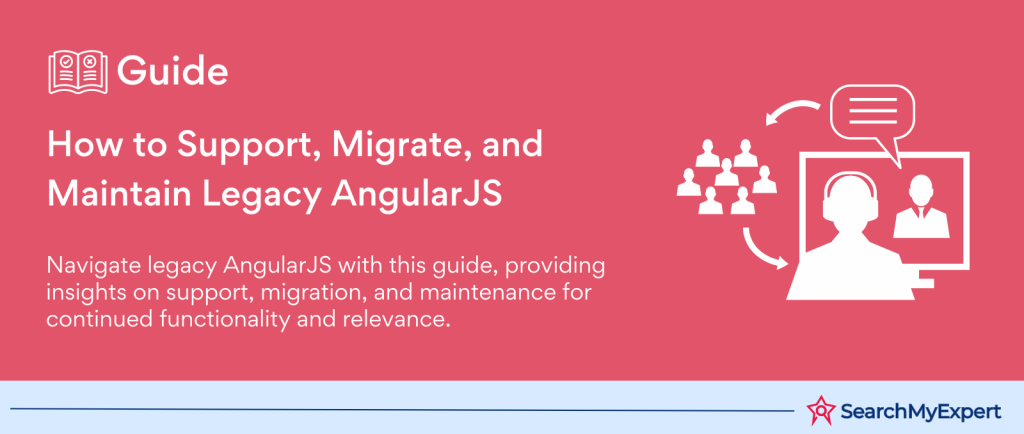AngularJS in the Modern Web Development Era
In the fast-evolving realm of web development, AngularJS once stood as a pioneering framework that reshaped how developers approach single-page application design. Its introduction in 2010 heralded a new era of web applications, offering a robust structure for developing dynamic, efficient, and scalable web applications. However, as the digital landscape continued to advance, newer technologies emerged, leading AngularJS to its end-of-life status in December 2021. This milestone has profound implications for businesses and developers alike who still rely on this once cutting-edge technology for their web applications.
The End-of-Life Conundrum
The transition to AngularJS’s end-of-life phase is not just a technical challenge; it’s a pivotal moment that calls for strategic decision-making. For many, AngularJS has been the cornerstone of their web development projects, powering everything from internal tools to customer-facing websites. The framework’s end-of-life status means there will be no further updates, security patches, or official support from the Angular team. This situation places applications at risk of security vulnerabilities, compatibility issues, and gradually, obsolescence in the face of modern web standards and expectations.
Implications for Legacy Applications
The cessation of support for AngularJS puts a spotlight on the urgent need for migration or upgrade strategies. Organizations are faced with several critical considerations:
- Security Risks:
Without ongoing security patches, applications are more susceptible to emerging threats, potentially compromising data integrity and user trust. - Maintenance Challenges:
The dwindling pool of developers familiar with AngularJS and the lack of official support complicate maintenance efforts, driving up costs and time investment. - Innovation Stagnation: Sticking with a legacy framework can hinder the adoption of modern web development practices and technologies, limiting the ability to innovate and meet evolving user expectations.
Embracing the Future
While the end-of-life status of AngularJS poses significant challenges, it also presents an opportunity for growth and transformation. Migrating to newer technologies not only addresses the immediate concerns of security and support but also paves the way for leveraging the latest advancements in web development. This evolution can lead to improved performance, enhanced user experiences, and more maintainable codebases, ensuring that applications remain competitive and relevant in the digital age.
The journey from AngularJS to the future of web development is fraught with complexities, but with careful planning, the right resources, and a strategic approach, organizations can navigate this transition successfully. The following sections of this article will delve deeper into understanding the options available for migration, strategies for a smooth transition, and how to harness the potential of modern frameworks to rejuvenate legacy applications.
Remaining Beacons: Navigating AngularJS Community Resources in the Post-Support Era
Despite AngularJS reaching its end-of-life, a vibrant community of developers and enthusiasts continues to keep the legacy of this framework alive. Various forums, websites, and groups have emerged as vital resources for those still working with AngularJS, offering advice, solutions, and even limited support to navigate the challenges of maintaining legacy applications. This section highlights the most active AngularJS community resources and identifies key individuals and companies that play a crucial role in providing ongoing support.
Active Community Forums and Websites
- GitHub Repositories: The open-source nature of AngularJS has led to the proliferation of GitHub repositories where developers share fixes, forked versions of the framework, and custom updates. These repositories are invaluable for finding patches to specific issues or enhancements made by the community.
- Stack Overflow:
This platform remains a goldmine for AngularJS developers, with thousands of questions tagged with angularjs, covering a wide range of topics from troubleshooting to best practices. The community-driven Q&A format makes it easy to find solutions or ask new questions. - Reddit: The AngularJS subreddit (/r/angularjs) is a hub for discussions, news, and questions about AngularJS. It’s a place to connect with other developers, share insights, and keep up with any developments related to legacy AngularJS projects.
- Gitter and Slack Channels: Various AngularJS communities exist on Gitter and Slack, offering more direct and real-time communication channels for developers seeking advice or collaboration opportunities. These platforms facilitate discussions on specific challenges and share updates or resources relevant to AngularJS.
Highlighted Individuals and Companies
- Freelance Developers:
A number of experienced AngularJS developers have transitioned to freelance consulting, offering their expertise to businesses and projects requiring maintenance or migration services. These individuals often share their insights through blog posts, GitHub contributions, or community forums. - Development Agencies:
Some specialized web development agencies continue to support AngularJS, recognizing the need for maintenance and migration services for legacy applications. These companies provide tailored solutions, leveraging their extensive experience with AngularJS to address complex challenges. - Open-Source Contributors:
Certain key figures in the AngularJS community have taken on the mantle of maintaining forks of AngularJS or contributing significantly to community-driven patches and updates. Their work ensures that critical fixes and enhancements are available to those who need them.
Leveraging Community Knowledge for Legacy Support
The active participation of these resources and individuals plays a critical role in the ongoing viability of AngularJS applications. By engaging with these communities, developers can find not just technical solutions, but also moral support and guidance from peers who understand the unique challenges of working with a legacy framework.
Practical Steps to Engage with the Community
- Participate in Forums and Discussions:
Regularly visiting and contributing to discussions on platforms like Stack Overflow and Reddit can provide fresh insights and solutions to common problems. - Follow Key Contributors: Keeping tabs on influential developers and companies within the AngularJS community can lead to valuable resources and advice, often shared through blogs or social media.
- Contribute to Open-Source Projects: Engaging with GitHub projects related to AngularJS not only helps improve the ecosystem but also deepens your understanding and expertise in dealing with legacy issues.
Enhancing Legacy AngularJS Applications: Third-Party Solutions and Libraries
In the wake of AngularJS’s end-of-life, the demand for strategies to extend the lifespan of legacy applications has surged. Fortunately, the wider web development ecosystem has responded with a variety of third-party solutions and libraries designed to offer extended support, maintenance, and security patching for AngularJS projects. This section explores some of the key tools and libraries that have become indispensable for developers seeking to maintain, improve, and secure their AngularJS applications against the backdrop of a discontinued official support framework.
Key Third-Party Libraries for Extended Support
- ngUpgrade: For teams looking towards the future while needing to maintain current functionality, ngUpgrade offers a bridge between AngularJS and the latest Angular versions. It enables incremental upgrading, allowing developers to run both frameworks side by side in the same application, facilitating a smoother transition.
- UI-Router: This state-based routing library for AngularJS continues to be updated and maintained, offering advanced routing capabilities that are essential for complex applications. Its continued support ensures that applications can maintain sophisticated navigation schemes without a complete rewrite.
- AngularJS Material: Providing UI components for AngularJS applications, AngularJS Material has seen continued interest from the community, ensuring that applications can still leverage modern, responsive design elements even within the legacy framework.
Tools for Security Patching and Compatibility
- Snyk: Recognizing the security vulnerabilities that come with using a legacy framework, Snyk offers tooling specifically designed to identify and patch known vulnerabilities in AngularJS applications. Its database of security patches is regularly updated, providing a layer of protection against potential exploits.
- Webpack: While not exclusive to AngularJS, Webpack can be configured to optimize and maintain legacy AngularJS applications, ensuring they remain compatible with modern browsers and JavaScript standards. It’s particularly useful for bundling and minimizing code, improving load times, and integrating modern JavaScript features.
- Babel: As a JavaScript compiler, Babel can transpile newer ECMAScript code back to the version compatible with AngularJS, ensuring that developers can still use the latest JavaScript features without sacrificing compatibility.
Navigating the Ecosystem of Support
The availability of these third-party solutions highlights the vibrant ecosystem that has evolved around AngularJS, even post-official support. By leveraging these tools and libraries, developers can not only address immediate concerns such as security vulnerabilities and compatibility issues but also plan for a more structured migration to newer frameworks when the time is right.
Implementing Third-Party Solutions
Implementing these third-party solutions requires a strategic approach, balancing the immediate benefits of extended support and security patching with the long-term goal of migrating to a modern framework. Here are a few tips for integrating these tools into your AngularJS projects:
- Assess Your Needs:
Determine which areas of your application require the most attention—security, compatibility, UI components—and select tools that specifically address those needs. - Plan for Incremental Upgrades: Utilize libraries like ngUpgrade to gradually migrate your application to Angular, reducing the risk of disrupting existing functionality.
- Stay Informed:
Keep abreast of updates and new tools in the AngularJS ecosystem. Active community forums and developer blogs are excellent resources for the latest recommendations and best practices.
Essential Maintenance Strategies for AngularJS Applications
Maintaining a legacy AngularJS application in a post-end-of-life world requires a focused approach to ensure both the security and functionality of your software. As the official support for AngularJS has ceased, the responsibility for keeping applications secure, efficient, and bug-free has shifted entirely to developers and their organizations. This section outlines best practices for prioritizing security updates, bug fixes, and strategies for mitigating known vulnerabilities, ensuring that your AngularJS applications remain robust and reliable.
Prioritizing Security Updates and Bug Fixes
Conduct Regular Security Audits
- Utilize tools like Snyk or OWASP Dependency-Check to scan your AngularJS application for known vulnerabilities. Regular audits help identify security risks promptly, allowing for immediate remediation.
Implement Automated Testing
- Leverage automated testing frameworks to continuously test your application for bugs and security flaws. Tools like Jasmine or Karma are well-suited for AngularJS applications and can significantly streamline the testing process.
Adopt a Patch Management Process
- Establish a systematic approach to applying security patches and updates. Prioritize patches based on the severity of the vulnerabilities they address, applying critical updates as soon as possible while scheduling less critical updates in a timely manner.
Monitor Dependency Security
- Since AngularJS applications often rely on third-party libraries, it’s crucial to monitor these dependencies for updates or security advisories. Use tools like npm audit or Yarn to check for vulnerable packages and update them accordingly.
Strategies for Mitigating Known Vulnerabilities
Isolate Legacy Code
- If possible, isolate legacy AngularJS code from newer parts of your application. This approach minimizes the risk of vulnerabilities in the legacy code affecting the overall application security.
Utilize Content Security Policy (CSP)
- Implementing CSP can significantly reduce the risk of XSS (Cross-Site Scripting) attacks by specifying which dynamic resources are allowed to load. This is particularly important for AngularJS applications due to their reliance on client-side rendering.
Sanitize User Input
- Ensure all user input is sanitized to prevent injection attacks. Although AngularJS provides some built-in protections, it’s crucial to review and reinforce these measures, especially in older applications.
Regularly Update Third-Party Libraries
- Beyond monitoring, actively update third-party libraries to versions that have addressed known security issues. This practice should be part of your regular maintenance routine to close potential security gaps.
Educate Your Team
- Keeping your development team informed about best practices in security and maintenance is critical. Regular training sessions on secure coding practices, recent vulnerabilities, and their mitigations can empower your team to proactively maintain and improve the application’s security posture.
Future-Proofing Your Web Presence: The Path from AngularJS to Modern Frameworks
As the digital world continues to evolve, the importance of adapting and modernizing legacy systems cannot be overstated. For organizations reliant on AngularJS for their web applications, planning for the future means considering migration paths to newer, actively supported frameworks. This transition is not just about maintaining technological relevance; it’s about leveraging the advancements in web development to enhance performance, security, and user experience. This section offers insights into the significance of migration and provides resources and guidance to navigate the process effectively.
The Importance of Migration
Enhanced Security and Performance
Migrating to a modern framework ensures your application benefits from the latest security measures, reducing vulnerabilities and improving overall performance. Modern frameworks are optimized for speed and efficiency, offering a better experience for end-users.
Access to New Features and Integrations
Newer frameworks come with a plethora of features that support the latest web standards, allowing for the creation of more dynamic, interactive, and engaging user interfaces. Additionally, they offer better integration capabilities with other tools and services, opening up new possibilities for application functionality.
Improved Developer Productivity
Modern frameworks provide enhanced development tools, streamlined workflows, and a more intuitive coding environment. This not only accelerates development times but also makes it easier to attract and retain talent familiar with the latest technologies.
Planning Your Migration
Assess Your Current Application
- Begin by thoroughly assessing your existing AngularJS application to understand its architecture, dependencies, and functionalities. This assessment will guide your migration strategy, helping you decide between a complete rewrite or an incremental approach.
Choose the Right Target Framework
- Evaluate modern frameworks such as Angular, React, or Vue.js, considering factors like performance, scalability, community support, and compatibility with your current technology stack.
Develop a Migration Plan
- Based on your assessment and target framework, outline a detailed migration plan. This plan should include milestones, resource allocation, risk management strategies, and a timeline.
Leverage Migration Tools and Resources
- Utilize tools and libraries designed to facilitate migration. For instance, ngUpgrade allows for an incremental migration from AngularJS to Angular by running both frameworks side by side.
Test Thoroughly
- Implement a comprehensive testing strategy to ensure that the migrated application meets all functional, performance, and security requirements.
Train Your Team
- Ensure your development team is up to speed with the new framework through training sessions, workshops, and access to online courses and resources.
Resources and Guidance
- Angular Official Migration Guide:
The Angular team provides extensive documentation and guides for migrating from AngularJS to Angular, offering best practices, tools, and tips for a smooth transition. - React and Vue.js Communities: Both React and Vue.js boast vibrant communities with a wealth of resources, including tutorials, forums, and third-party tools, to assist in the migration process.
- Development Agencies Specializing in Migration: Consider partnering with a development agency that specializes in framework migration. They can provide expertise, resources, and additional manpower to accelerate the migration process.
Building a Support Network for AngularJS
In the realm of legacy AngularJS applications, the collective wisdom and collaboration of the developer community emerge as invaluable assets. As official support for AngularJS has sunsetted, the power of community-driven support networks has never been more critical. This final step emphasizes the importance of connecting with other developers, fostering a collaborative environment to navigate the challenges of maintaining AngularJS applications. Here, we explore strategies for building your own support network, collaborating on solutions, and sharing knowledge to enhance the sustainability and functionality of AngularJS projects.
The Power of Community Collaboration
The discontinuation of official AngularJS support has led to a unique scenario where developers and organizations must rely on each other to solve problems, share fixes, and innovate within the framework’s confines. This collaborative effort not only compensates for the lack of official resources but also enriches the developer experience through shared challenges and victories.
Connecting with Other Developers
- Online Forums and Social Media:
Platforms like Stack Overflow, Reddit, and LinkedIn offer vibrant communities where AngularJS developers gather to ask questions, share insights, and offer support. Participating in these forums can connect you with like-minded individuals facing similar challenges. - Local Meetups and Conferences:
Attending local meetups, conferences, or workshops focused on AngularJS or web development in general can provide networking opportunities and foster personal connections with other developers who have valuable experience and insights. - Open Source Projects:
Contributing to or starting an open-source project related to AngularJS can attract other developers interested in supporting, using, or contributing to your efforts. This can be an excellent way to collaborate on solutions and share knowledge.
Collaborating on Solutions
- Shared Code Repositories: Platforms like GitHub or GitLab are perfect for hosting shared projects where developers can collaborate on building libraries, tools, or patches that enhance the AngularJS ecosystem.
- Documentation and Guides: Contributing to community-driven documentation, blogs, or tutorials about maintaining AngularJS applications can help preserve and disseminate collective knowledge. This is especially valuable for uncommon issues or innovative solutions.
- Peer Code Reviews: Engaging in peer code reviews with other AngularJS developers can offer new perspectives on your code, uncovering potential improvements or security issues. It’s a mutually beneficial practice that enhances code quality and fosters learning.
Sharing Knowledge and Resources
- Organize Workshops or Webinars:
Hosting educational sessions on topics relevant to AngularJS maintenance, migration strategies, or specific challenges can help disseminate knowledge and best practices across the community. - Create a Shared Resource Library:
Compiling a digital library of tools, libraries, articles, and tutorials related to AngularJS maintenance can be an invaluable resource for developers. Consider setting up a website or a GitHub repository where this information can be easily accessed and updated by the community. - Mentorship Programs:
Participating in or establishing mentorship programs can help less experienced developers navigate the complexities of AngularJS, ensuring the continued vitality and innovation within the ecosystem.
Navigating the Future of AngularJS Applications
As we navigate the complexities of maintaining AngularJS applications in a post-end-of-life landscape, the importance of diligent maintenance, strategic long-term planning, and community engagement cannot be overstated. AngularJS, a framework that once set the standard for dynamic web applications, has left a lasting legacy in the web development world. The journey ahead for those who continue to rely on this framework requires a balanced approach—addressing immediate maintenance needs while also preparing for a future built on newer, more robust technologies.
Emphasizing Careful Maintenance
In the absence of official support, the responsibility for keeping AngularJS applications secure, functional, and efficient falls squarely on developers and their organizations. Prioritizing security updates, implementing rigorous testing procedures, and adopting best practices for legacy code management are essential steps to mitigate risks and ensure the longevity of your applications. Engaging with the broader AngularJS community for support and insights can provide additional layers of resilience against the challenges that lie ahead.
The Critical Role of Long-Term Planning
While maintaining your current AngularJS applications, it’s crucial to look towards the future. Planning for migration to a modern framework is not just a technical necessity; it’s an opportunity to revitalize your web presence, enhance user experiences, and embrace the latest in web development innovations. This transition should be approached with a strategic mindset, considering factors such as project timelines, resource allocation, and the potential for retraining your team to master new technologies.
Staying Informed and Prepared
To stay ahead in the ever-evolving landscape of web development, here are resources for keeping informed about critical security updates and best practices:
- Security Advisory Platforms: Utilize platforms like Snyk or the National Vulnerability Database to monitor for vulnerabilities that may affect your AngularJS applications.
- Web Development News Sites:
Follow reputable web development news platforms and blogs for the latest trends, updates, and security advisories in the tech world. - Community Forums and Social Media:
Engage with web development and AngularJS-specific forums, social media groups, and mailing lists for real-time advice, insights, and updates from peers and experts in the field. - Professional Development Resources:
Invest in continuous learning through online courses, webinars, and workshops focused on modern web development frameworks and security best practices.
Conclusion
The transition from AngularJS represents both a challenge and an opportunity for growth. By embracing careful maintenance practices, engaging with the developer community, and planning for future technological advancements, organizations can navigate this transition successfully. The journey from AngularJS to modern frameworks is a testament to the resilience and adaptability of the web development community, reflecting a commitment to innovation and excellence in the digital age.
Craft bespoke web solutions with our Angular JS Development Service Company.
Table of Contents
Toggle






